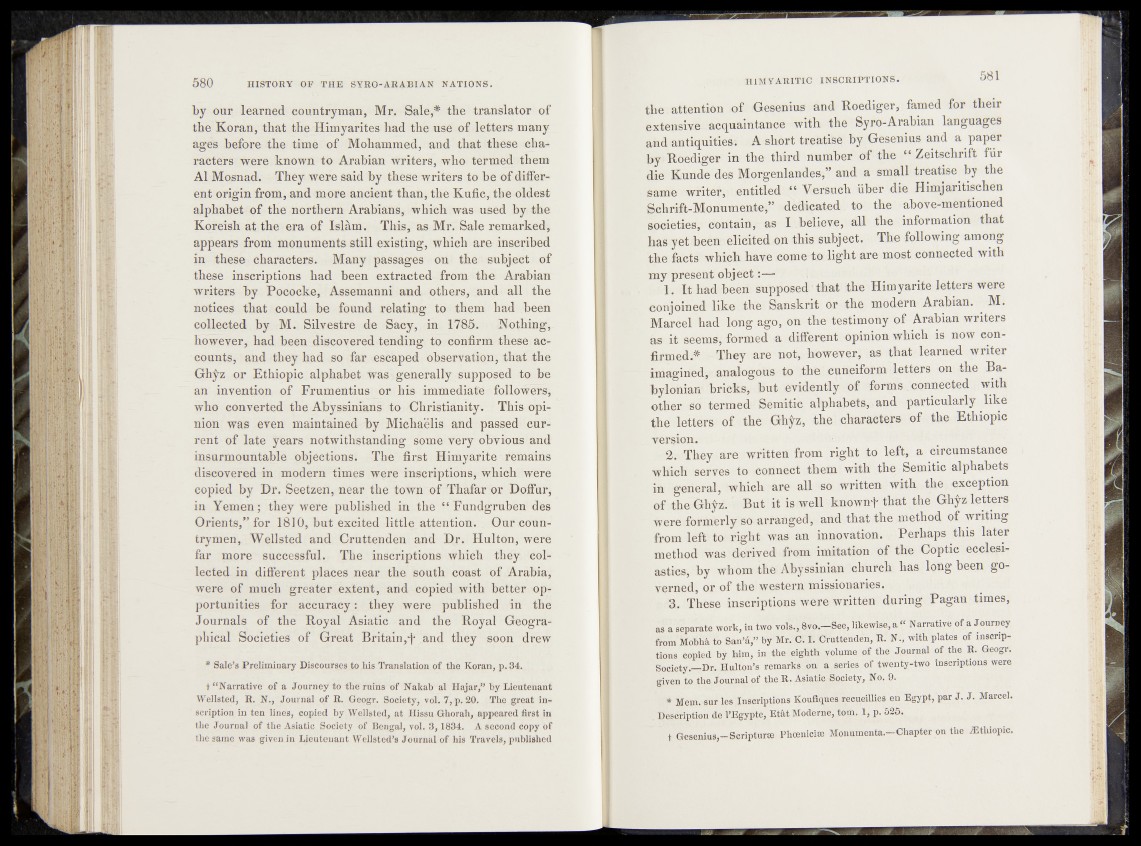
by our learned countryman, Mr. Sale,# the translator of
the Koran, that the Ilimyarites had the use of letters many
ages before the time of Mohammed, and that these characters
were known to Arabian writers, who termed them
A1 Mosnad. They were said by these writers to be of different
origin from, and more ancient than, the Kufic, the oldest
alphabet of the northern Arabians, which was used by the
Koreish at the era of IsRlm. This, as Mr. Sale remarked,
appears from monuments still existing, which are inscribed
in these characters. Many passages on the subject of
these inscriptions had been extracted from the Arabian
writers by Pococke, Assemanni and others, and all the
notices that could be found relating to them had been
collected by M. Silvestre de Sacy,, in 1785. Nothing,
however, had been discovered tending to confirm these, accounts,
and they had so far escaped observation, that the
Gh^z or Ethiopic alphabet was generally supposed to be
an invention of Frumentius or his immediate • followers,
who converted the Abyssinians to Christianity. This opinion
was even maintained by Michaëlis and passed current
of late years notwithstanding some very obvious-and
insurmountable objections. The first Himyarite' remains
discovered in modern times were inscriptidhs* which were
copied by Dr. Seetzen, near the town of Thafar or Doffur,
in Yemen ; they were published in thé m Fundgruben des
Orients,” for 1810, but excited little attention. . Our countrymen,
Wellsted and Cruttenden and Dr. Hultojn, were
far more successful. The inscriptions which they cob
leeted in different places near the south coast of Arabia,
were of much greater extent, and copied with better opportunities
for accuracy: they were published in the
Journals of the Royal Asiatic and the Royal Geographical
Societies of Great Britain ,-f* and they soon drew
* Sale’s Preliminary Discourses to his Translation of the Koran, p.34.
t “ Narrative of a Journey to the ruins of Nakab al Hajar,” by Lieutenant
Wellsted, R. N., Journal of R. Geogr. Society, vol. 7, p. 20. The great inscription
in ten lines, copied by Wellsted, at Hissu Ghorab, appeared first in
the Journal of the Asiatic Society of Bengal, vol. 3,1834. A second copy of
the same was given in Lieutenant Wellsted’s Journal of his Travels, published
the attention of Gesenius and Roediger, famed for their
exteiisive acquaintance with the Syro-Arabian languages
and antiquities; A short treatise, by Gesenius and a paper
by Roediger in the third number of the M Zeitschrift für
die Kunde des Morgenlandes,” and a small treatise by the
same writer,: entitled Versuch über die Himjaritisehen
Schrift-Monumente,” dedicated to the above-mentioned
societies, contain, as I believe, all the information that
has yet -been- elicited on this subject. The following among
the facts which have eome~te;h#it are most connected with
my present object :— ! >. :. v^ -■
1. It had been supposed - that the Himyarite letters were
conjoined like the Sanskrit or the modem Arabian. M.
Marcel had long ago, on the-testimony of Arabian writers
as it seems, formed n different opinion which is now confirmed.*
They are not, however/ras that learned writer
imagined; analogous to the cuneiform-letters on the Baby
Ionian bricks, but evidently of forms,connected with
other so termed.^ Semitic alphabet's, -and particularly like
the letters’ of the Ghy-z, the characters of the Ethiopie
version. : : u
, • 2. They are written from right to left, a circumstance
which serves to connect them with the Semitic alphabets
in general, which are all so written with the exception
of the Ghÿz. | But it is well knoyvtt that tffb Ghÿz letters
were formerly sô/arranged, and that the method of writing
from left to right was an innovation. Perhaps this later
method Was derived from imitation of the Goptic ecclesiastics,
by whom the Abyssinian chureh has long been governed,
or of the western.missionaries.
3. These inscriptions were written during Pagan times,
as a separate work, in twovoIs^'Svo —See, likewise, a fW r a tiv f e o f a Journey
from Mobhâ to San’â,” by Mr. Gi t. Cruttenden, k.4N., With plates of inscriptions
copied by him, in the eighth of the Journal flf Jh « R- öeogr*
Society.__Dr. Hplton’s rem a rk so n T o r i e s .of twenty-twp inscriptions were
given to the Journal of the R . Asiatit%|^iety, No. 9.
* Mem. sur les .Inscriptions Koufiq^eâ^ciieillies en Egypt, par J. J. Marcel.
. description de l'Egypte, E tâ t Moder|l|,tom. 1,, p. 535.
t Gesenius,-S c rip tu ræ Phoeniciæ Monumenta.-Chapteron theÆthiopic.